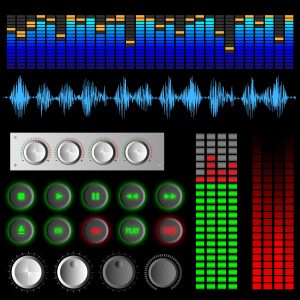Less is More – Using Apple as an Example to Apply Minimalism in the AV Industry

This week, I would like to explore the crossroads we often come to when we want to add technology to a space. It is so easy to get all “wound up” on all the AV technology possibilities we could do with a space. However, when all is said and done, that space could easily end up looking like a scene from Star Trek, which is so overwhelming and intimidating. Truthfully, would you want to operate a display like the picture to the left? Buttons, lights, flashing, neon, knobs, no thanks.
As an AV designer, you want people to have a feeling of comfort and ease when they enter a room, plus you want them to stay for a while. This will also set the stage for a well-received presentation too. So how do we balance the need for potentially advanced and complicated AV equipment with the need for comfort and beauty? We apply minimalist principles. Let’s use the iPhone as a successful example.
Addison Duvall, from speckyboy design magazine, states, “There’s a lot more to simple design than you think. A product such as the iPhone may appear clean and unobtrusive to the naked eye, but there’s a lot going on beneath the surface that most people don’t know about. Nor do they need to. They only need to know that it will do what they need it to do, when they need it to do it.”
In May of 2012, Time Magazine did a feature article on Apple and listed six reasons Apple has been so successful. I believe those six reasons can easily be applied to the AV industry, as a whole, and your AV company, specifically. Let’s dive in:
For any product that Apple creates, the people who create it have to want it themselves. This is also true for the AV products that we are offering to our customers. If you wouldn’t use it, don’t sell it.
The products have to be easy to use. Jobs was a stickler on this point. While industrial design is a critical component of any product Apple makes, if it is not easy to use, it is considered worthless to the consumer. For the AV industry, our equipment can be equally intimidating, so we need to make sure even the most inexperienced user can follow our instructions.
Keep things simple. Yes, there are tech-savvy people who like more choices and sometimes even like complexity. But the majority of users are not tech-savvy and keeping things simple for them is a plus. Apple understands this in spades and is never tempted to add multiple versions of an iPhone, iPad or even more than one or two types of iPods. This makes buying an Apple product simple. As AV professionals, we should do the same. When you discover a product or product line you absolutely love, stick with it.
Offer great customer service and in-store experiences. Jobs understood one of the major conundrums of technology: even if you create products that are easy to use, the variety of things that people want to use technology for often creates complexity. Because of this, consumers at all levels may need some hand holding from time to time. Apple uses this conundrum to its advantage. Because it keeps product SKUs simple, the salespeople inside the stores know the products really well. Notice that when you go into an Apple store and are greeted by one of the sales staff, you’re not asked, “How can I help you?” Instead they ask, “What would you like to do today?” They go right to the heart of any technology user’s question, a question that’s always related to what they want to do with the technology the user is interested in. I really appreciate that question and this perspective. Isn’t that what AV professionals do every day? We help our customers to accomplish their AV goals, start to finish and maintenance.
Apple only makes a product if Apple can do it better. Apple normally doesn’t invent a new product or product category. As Apple designer Jonathan Ive said, “Our goals are very simple — to design and make better products. If we can’t make something that is better, we won’t do it.” This is another good principle to apply to AV design. Don’t change a space design for the sake of change. Always keep “Make this better” at the forefront of your thoughts when designing a room and choosing equipment.
Apple stays at least two years ahead of its competitors. While those competing with Apple are just getting products to market that are competitive, Apple is already working on the products at least two years out. And while we may not be in the AV product design segment of our industry, we definitely need to research the upcoming trends and products. Make connections and partnerships with your favorite product designers so you can have insider information of release dates and timelines.
Less is more. Keep it simple. Hope this helped to bring you back to basics.

